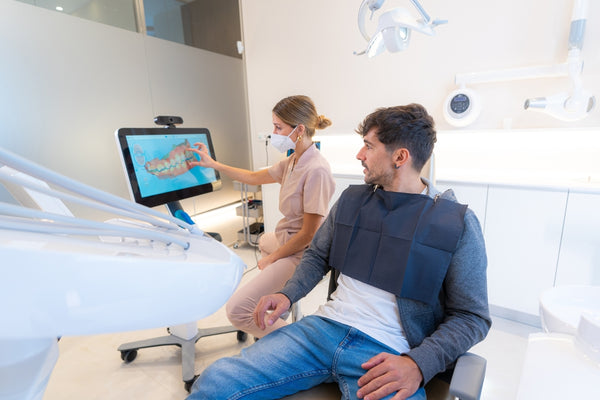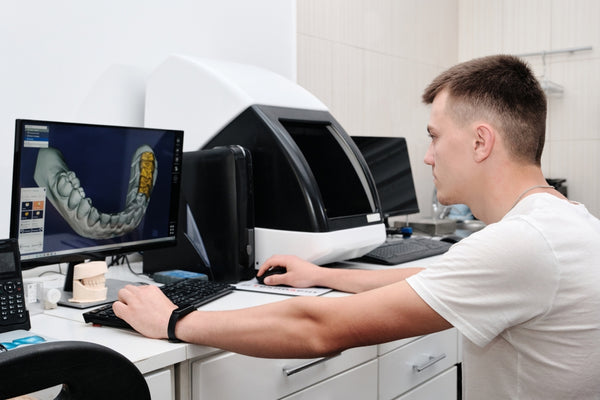
Top Trends in Dentistry: Innovative Products Shaping the Future of Dental Care
The future of dental care is taking shape right before our very eyes. Advances like AI, machine learning, robotics, 3D-printing etc., are changing how dentists approach diagnosis, treatment, and patient care.
The days of avoiding dental appointments and enduring invasive procedures may soon become a relic of the past, thanks to the transformative power of innovative products in dentistry. Today, only about 35% of working-age adults in the US visit the dentist annually. More than 44% avoid appointments because they are too anxious or afraid. In fact, dental insurance and dental anxiety are the top reasons people skip dental appointments.
But with innovations like virtual reality (VR) or teledentistry, the narrative is poised to shift, making dental care more accessible, affordable, personalized, and anxiety-free. With that said, this article will talk about cutting-edge trends in dentistry. We'll showcase innovative dental equipment and products that are changing how dental professionals deliver care.
Technologies Transforming the Field of Dentistry

Innovation drives healthcare more than any other force, and in the coming years, it will continue to advance in many ways. Here's how emerging technologies and products revolutionize patient care, diagnosis, treatment, and dental practice.
Artificial Intelligence and Machine Learning
AI and machine learning applications in dentistry can be classified into diagnosis, treatment planning, prediction of treatment outcomes and decision-making. But the most popular application is diagnosis. AI is more consistent than dentists in diagnosing tooth decay from peripheral and bitewing radiographs. That's because the algorithms have been trained using billions of datasets, allowing them to recognize intricate patterns and subtle indicators that may escape the human eye.
AI processes vast datasets, including patient genetics, lifestyle, and medical history, to generate personalized treatment plans. Dentists can leverage this information to tailor interventions to each patient's specific needs, improving treatment efficacy and patient satisfaction. On top of that, AI algorithms can help prevent common treatment errors by providing real-time assistance to dentists. This includes guidance on procedures, identifying potential issues, and ensuring adherence to best practices.
Augmented Reality/Virtual Reality in Dentistry
Integrating Augmented Reality (AR) and Virtual Reality (VR) in dentistry marks a revolutionary stride toward enhancing patient experience and professional training.
These immersive technologies offer patients a novel and engaging perspective on their oral health.

AR and VR in Patient Care
AR facilitates the creation of 3D visualizations, allowing dentists to illustrate procedures with unprecedented clarity. Patients can witness virtual models of their teeth and gums and understand proposed treatments. This empowers them to make informed decisions about their oral care.
VR, on the other hand, transforms the patient experience by providing a distraction during procedures. Dedicated headsets close off the outside world and immerse patients in calming virtual environments. This helps alleviate the anxiety that's often associated with visiting dental clinics. VR can be particularly effective in pediatric dentistry, where managing anxiety is crucial for fostering positive dental experiences in young patients.
AR and VR in Learning
Beyond patient care, AR and VR are invaluable tools in dental school and professional training. Augmented reality enables dental students to visualize complex dental structures in 3D, enhancing their understanding of anatomy and procedural nuances. Virtual reality simulations offer a risk-free environment for students to practice various dental procedures and receive real-time feedback as their movements are tracked. This helps them refine their skills before entering the clinical setting.
Teledentistry
Teledentistry redefines the traditional boundaries of dental care and increases accessibility for patients worldwide. It leverages digital communication technologies to facilitate remote consultations, diagnostics, and treatment planning. In the social media age, where more people have digital devices, virtual video conferencing and digital imaging allow dentists to remotely assess oral health conditions, provide consultations, and offer preliminary diagnoses. This is particularly helpful for individuals in remote or underserved areas, where access to dental care may be limited.
Computer-Assisted Design and 3D-printing
 CAD/CAM and 3D printing systems are setting new stages in dental prosthetic fabrication, offering precision, efficiency, and customization. CAD in dentistry involves using digital software to create highly detailed and accurate designs for dental prosthetics such as crowns, bridges, and implants. Integrating 3D printing in dentistry takes these digital designs from the virtual realm to tangible, patient-specific prosthetics.
CAD/CAM and 3D printing systems are setting new stages in dental prosthetic fabrication, offering precision, efficiency, and customization. CAD in dentistry involves using digital software to create highly detailed and accurate designs for dental prosthetics such as crowns, bridges, and implants. Integrating 3D printing in dentistry takes these digital designs from the virtual realm to tangible, patient-specific prosthetics.
Traditionally, dentists had to create a mold of the tooth and a temporary crown for patients. They would then wait for the lab to make a permanent crown. But now, 3D printing offers a faster, cheaper way to create splints, aligners, and retainers. Most of these can be completed in just over an hour.
Dental professionals also use technologies like cone beam computed tomography to create a volumetric image of a patient's dental structure and a 3D model of their jaw. They can then use this to plan specific surgical interventions or assess the impact of treatments.
Laser Technology
Laser technology offers a non-invasive alternative to traditional methods, providing a gentler and more patient-friendly approach to tooth preparations and dental feelings, cavity detection, treating tooth sensitivity and, most recently, tooth regeneration. Scientists at the University of Buffalo in NYC are testing low-power laser light to stimulate tooth regeneration. At the moment, dentists perform root canal when decay reaches the pulp. However, the scientists found that pointing the laser directly at the remaining pulp can stimulate stem cells to produce new dentin.
Advancements in Materials
Rapid advances have also been made in the research and development of improved biomaterials for dental restorations. Modern biomaterials exhibit enhanced strength, durability, and biocompatibility, addressing the evolving demands of restorative dentistry. High-performance ceramics and composite resins, for instance, have become the forefront choices for crowns, bridges, and veneers due to their ability to closely mimic the natural appearance of teeth while providing lasting structural integrity. These materials offer superior esthetics and contribute to reduced wear and increased longevity of dental restorations.
Innovative Dental Products at Dental Finds
If you are eager to elevate your clinical capabilities and stay on top of the latest industry trends, Dental Finds invites you to explore its extensive catalog. Dental Finds has cutting-edge products that will not only enhance your practice but also contribute to the delivery of exceptional and advanced dental care. Take the next step in advancing your dental practice by discovering the innovative products available at Dental Finds. Your journey into the future of dentistry begins here.

